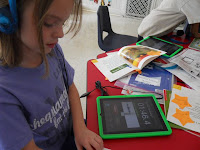 You know how the first time you teach something you tend to overlook some key details? Kicking off the fluency recordings went sort of like that. By now (day 3), we've worked out the kinks. But it wasn't very smooth on our first try.
You know how the first time you teach something you tend to overlook some key details? Kicking off the fluency recordings went sort of like that. By now (day 3), we've worked out the kinks. But it wasn't very smooth on our first try.We were working with a group of 5 second graders at a time. The kids are using the built-in mics to record, and it took a fair amount of practice to get the students to speak at an appropriate volume, because I hadn't thought to model that. Since students practice being audible when reading to a live audience, they were a bit too audible for their practice recordings. This resulted in a lot of background noise on all the first recordings and general irritation on the part of our second graders. I also had forgotten to point out where the microphone is located and that recording on the iPad works best if they flip it around so the microphone and headphone jack are closest to them. These were issues that hadn't turned up when I tested it alone in an empty classroom -- the reality of a group of students working in a bustling classroom pointed out my blind spots pretty quickly.
Also, I had been so pleased with my lovely Blue Fire Screen Shots I neglected to realize that second graders wouldn't necessarily have the strategies to use a step-by-step guide like that. As with any reading and comprehension of printed materials, you have to be explicit.
Finally, my first attempt at a rubric was a little confusing for some kids. I revised it to make the layout more clear; here's the revised rubric.

Yesterday I introduced the fluency center to a second classroom of students, and what a difference! I modeled the appropriate volume and showed them how to monitor their own volume by watching the size of the "bumps" on screen. I showed them how to think of the headphone cable as an arrow pointing to where they should talk. Maybe most importantly, I went step by step through the Screen Shots and modeled how to use them as a resource when they aren't sure what to do. I also modeled completion of the Fluency Self-Check Rubric after a single recording and how to start again at the beginning for a second try.
I know "teach explicitly" isn't the most earth-shattering advice, but I think it is easy to overestimate what is intuitive for kids about technology, or to forget what issues will arise once the devices are in use by groups of students. I made the mistake of assuming a little too much and not being clear and explicit enough with the kids about the directions and the expectations. I forgot to show everything, not just tell. In an attempt take less classroom time with my explanation, I was less effective.

As a result of better teaching and more modeling, it's no surprise that the second and third days of fluency recordings were a huge improvement over the first. Now, we see the students reading, listening, reflecting, re-reading, practicing, and improving. The students were engaged and excited and genuinely focused on reading the passage better and better each time. We couldn't be more delighted with the students' progress -- as well as our own!
No comments:
Post a Comment